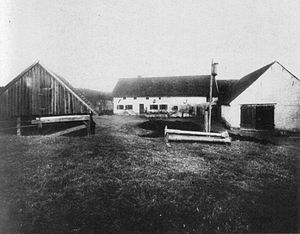 |
| Former Hinterkaifeck Farmstead (Source) |
The farmstead didn't have a true name. Kaifeck was a larger homestead roughly 1 km north. Hinter is a German prefix meaning "behind."
The inhabitants of the farmstead were Andreas Gruber, his wife Cazilia, their widowed daughter Viktoria, and her two children little Cazilia and Josef, who were 7 and 2 years old respectively. It was whispered among the neighbors that Josef was the son of Viktoria and Andreas, who had an incestuous relationship. The final victim was the maid, Maria Baumgartner.
Six months prior to the crime, the Gruber's maid left their service, claiming the house was haunted. The new maid, Maria, arrived only days before her own death.
In the days before their deaths, Andreas told neighbors about finding footprints in the snow leading out of the woods and to the homestead, but none leading back. He heard creaking in the attic and found a strange newspaper on the farm as well. The day before, the house keys went missing, but Andreas reported none of this to the police.
Though no one can say for sure what happened that night, it is believed that somehow the elderly couple, their daughter Viktoria, and her daughter Cazilia, were lured one by one into the barn where they were killed with a weapon resembling a pickax. Then the killer or killers went into the house and killed Josef, who slept in his mother's room, and Maria the maid, her own bedchamber.
When none of the inhabitants of Hinterkaifeck had been seen for several days, and young Cazilia hadn't shown up for school, neighbors went to the farmstead to check and found the grizzly scene.
Autopsies, performed the next day on location, showed that 7-year-old Cazilia lived for several hours after the assault. Lying beside the bodies of her mother and grandparents, she tore her hair out in tufts before succumbing to her injuries.
 |
| Shrine near Hinterkaifeck Farmstead (Source) |
At first, robbery was a suspected motive, but a great deal of money was soon discovered in the house. It's believed that the perpetrator(s) stayed at the farm after the murders, perhaps for days. They fed the livestock and ate the food in the kitchen. Neighbors reported seeing smoke from the chimney over the weekend, after the family would already have been dead, so there was plenty of time to discover the money.
The death of Karl Gabriel, Viktoria's husband who had reportedly died in the trenches of WWI in 1914, was called into question. His body had never been found.
In 2007, students of the police academy in Furstenfeldbruck were tasked with investigating the mystery with modern methods. They came to the conclusion that after so many years and the loss of so much evidence, it was impossible to solve the crime for certain. Tey did zero in on one person as a main suspect, but wouldn't release the name out of respect for still-living relatives. (Grrrh.)
Today, many amateur investigators still pour over the case.
What do you think of this case? Who do you think the main suspect in the 2007 investigation was?
No comments:
Post a Comment